the place where Paleontology and Paleoanthropology meets Philately
Finland
Mammoth on postmark of Finland
| << previous country | back to index | next country >> |
Contents:
- Country overview
- Philately of Finland
- Commemorative postmarks of Finland related to Paleontology
- Some personalized stamps of Finland related to Paleontology and Paleoanthropology
- References
- Acknowledgements
Finland, officially the Republic of Finland is a country in Northern Europe bordering the Baltic Sea, Gulf of Bothnia, and Gulf of Finland, between Norway to the north, Sweden to the northwest and Russia to the east.
Finland's population is 5.52 million (2018), and the majority of the population is concentrated in the southern region. Finland was inhabited when the last ice age ended, approximately 9000 BCE. The first settlers left behind artefacts that present characteristics shared with those found in Estonia, Russia and Norway. The earliest people were hunter-gatherers, using stone tools.
Finland was a province and then a grand duchy under Sweden from the 12th to the 19th centuries, and an autonomous grand duchy of Russia after 1809. Following the 1917 Russian Revolution, Finland declared itself independent.
During World War II, the Soviet Union sought repeatedly to occupy Finland, with Finland losing parts of Karelia, Salla, Kuusamo, Petsamo and some islands, but retaining their independence.
Finland transformed from a farm/forest economy to a diversified modern industrial economy; per capita income is among the highest in Western Europe. [R1]
Finland has produced postage stamps for use since 1856. [R2]
So far, Finland has not issued any stamps related to paleontology, but has issued a commemorative postmark depicting a Mammoth.
Commemorative postmarks of Finland related to Paleontology: Mammoth
Legend is here| 23.04.1985 "ESPOO-ESBO" [Sp] [PM1] | ||
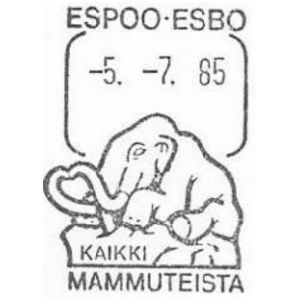 |
|
|
Notes:
[PM1] One of the most famous Mammoth discovered in Russia, is depicted on a postmark of Finland.
In 1985, the Finnish city Espoo hosted "All about Mammoths" (Kaikki Mammuteista in Finish, as stated on the bottom side of the postmark) exhibition. Finish and international Mammoth fossils, as well as remains of other Pleistocene mammals, which are often referred to as the Mammoth-steppe fauna: reindeers, gray wolves, wolverines, tundra birds, ice age horses were shown to the general public.
To date (2021), only some single Mammoth bones and teeth, have been found in Finland.
One such found is the molar tooth from Espoo (the place that hosted the show and where the postmark was introduced),
was described by A. Metzger in 1921 and according to radiocarbon analysis is about 43,000 years old.
It is the oldest Mammoth fossil found to date in Finland.
All other bones and teeth are dated between 25,000 and 15,000 years ago.
The tooth is hosted by Finnish Museum of Natural History, University of Helsinki to date.
[R5]
Dima was the only fully preserved Mammoth calf at that time. Since then, six other juvenile carcasses have been discovered in northern Siberia, but Dima is the best preserved Mammoth calf even today.
The calf was only 7-8 months old at the time of death about 40,000 years ago, according to radiocarbon dating. Traces of his mother's milk were found in his stomach.
Due to big international interest on the mummies, it was exhibited at many international shows.
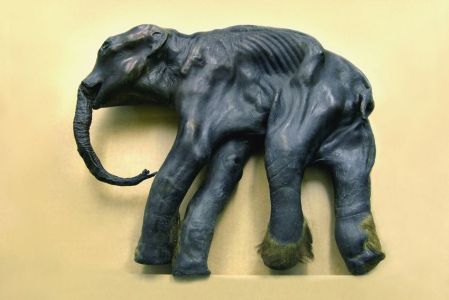
|
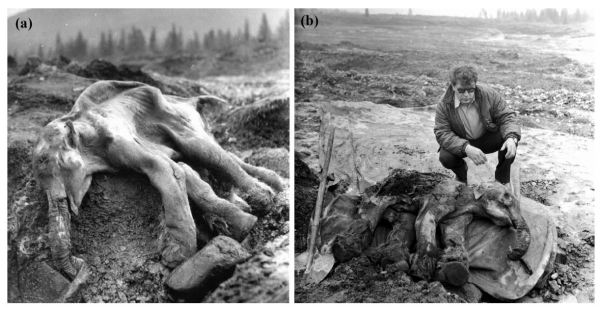
|
|
Mummy of the Mammoth Dima in Zoological Museum of the Zoological Institute of the Russian Academy of Sciences. After its discovery it was soaked in benzene and then embalmed with paraffin, the treatment removed almost every trace of hair and blackened the skin from its natural light brown to black. The image is from Zoological Institute of the Russian website. |
Photographs of Mammoth Dima taken at the discovery site: (a) shows the left, undamaged side of the baby Mammoth, (b) is of A. V. Lozhkin from the North East Interdisciplinary Science Research Institute (NEISRI) with Dima exhibiting the right side of the Mammoth that had been scraped by the bulldozer blade. The photos are from the article "About the age and habitat of the Kirgilyakh Mammoth (Dima), Western Beringia" by A.V. Lozhkin a, P.M. Anderson |
A complete frozen carcass of a young Mammoth was discovered on June 23, 1977, by bulldozer driver A. Logachev during mining operations near Kirgilyakh Creek, in Siberia, Russia (at that time USSR), known as the Kirgilyakh Mammoth.
Unfortunately, the bulldozer blade cut off part of the right side.
The calf also was informally named “Dima”, after a small stream, near which a Mammoth was discovered (Dima is also a boy’s name in Russian).
However, the Mammoth on the postmark is not Dima, but the reconstruction of another famous Russian Mammoth - the Berezovsky Mammoth, who is also chosen for a logo of Zoological Museum of the Zoological Institute of the Russian Academy of Sciences in St. Petersburg.
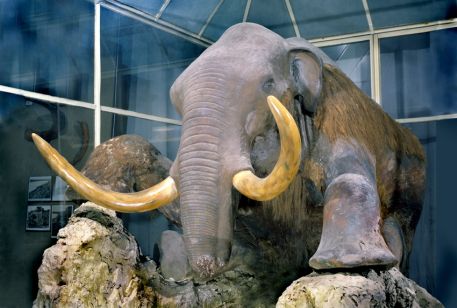
|
|
Reconstruction of the Berezovsky Mammoth in Zoological Museum of the Zoological Institute of the Russian Academy of Sciences. The image is from Zoological Institute of the Russian website. |
The Berezovsky Mammoth - is a unique specimen of an adult male Woolly Mammoth (Mammuthus primigenius)
that is well preserved (almost complete carcass, some skin and about 12kg of food fragments, include his last meal in the mouth)
in permafrost of Siberia in Russia.
It is named after the Berezovka River, on the banks of which it was found in 1900, frozen in the cliff.
The Mammoth was identified as a bull of age between 35 and 40, about 40,000 years old, according to radiocarbon dating.
His unusual pose and many broken bones suggest that he fell into a crevasse.
Due to the fact the plants in the mouth of the Mammoth had some seeds, it is happened at the end of the Summer or early Autumn,
when the surface soil was still mobile after summer thaw, but temperatures were dropping, allowing rapid freezing of the buried Mammoth.
[R3]
Some personalized stamps related to Paleontology and Paleoanthropology: Neanderthal, prehistoric animals
| 2004 "Neanderthals" | 2011 "Prehistoric animals" | |
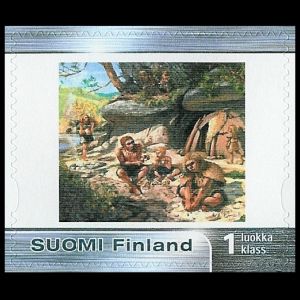 |
 |
|
References:
- [R1] Finland: Wikipedia WikiTravel FlagCounter
- [R2] Postal History and Philately of Finland:
Wikipedia
Links to official website of the Post Authority, stamp catalog and a list of new stamps of Finland are here - [R3] The Berezovsky Mammoth:
Wikipedia (in Russian),
Zoological Institute of the Russian (in Russian).
"Mammoths giants of the Ice Age", by Adrian Lister and Paul Bahn, ISBN: 978-0-7858-3328-4 - [R4] Mammoth Dima:
"About the age and habitat of the Kirgilyakh Mammoth (Dima), Western Beringia"
by A.V. Lozhkin a, P.M. Anderson
Mummipedia - [R5] Mammoth discoveries in Finland:
"New radiocarbon dates of Finnish Mammoths (Mammuthus sp.)"
by Pirkko Ukkonen, Juha Pekka Lunkka, Högne Jungner and Joakim Donner
Acknowledgements:
- Many thanks to Dick Mol a Dutch paleontologist for his help finding information about Mammoth exhibit in Finland in 1985.
- Many thanks to Dr. Peter Voice from Department of Geological and Environmental Sciences, Western Michigan University, for the draft page review and his very valuable comments.
| << previous country | back to index | next country >> |